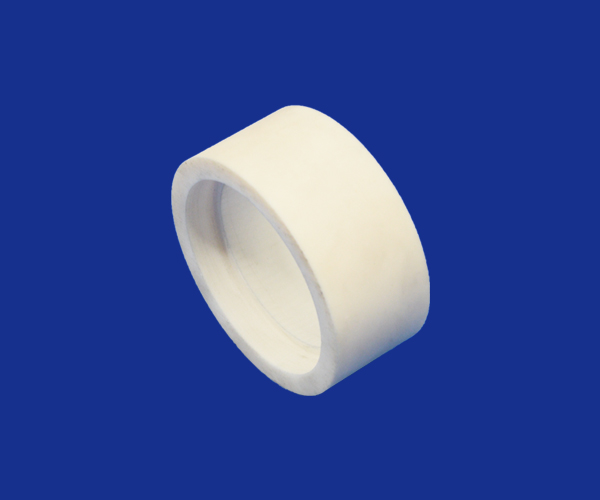Why ceramic parts processing to do electric crossing
The purpose of electroplating ceramic parts is to coat the surface of ceramic parts with metal, which not only increases the appearance, but also compensates the shortcomings of ceramic parts, gives the nature of metal, and gives full play to the characteristics of ceramic parts in one. Today, a large number of electroplating products of ceramic parts have been applied in electronics, automobiles, household products and other industries.
Process (1) Cleaning: remove the dirt and fingerprints left in the molding process of ceramic parts, which can be cleaned with alkali agent and then neutralized with acid immersion and washed with water.

(2) solvent treatment: make the surface of the ceramic parts wetting to act with the regulator in the next step.
(3) conditioning treatment (conditioning) : the surface of ceramic parts will be coarsened into the inner lock of the cavity so that the coating is tight and not easy to peel off, also known as chemical coarsening.
(4) Sensitization: The reducing agent is adsorbed on the surface. Commonly used is Stannous Chloride or other tin compounds, namely, Sn ^++ ions are adsorbed on the plastic surface with reducing properties.
(5) Nucleation: Catalytic substances such as gold and gold are adsorbed on sensitizing (reducing) surfaces, and then reduced into catalytic metal seeds, which can then be used in electroplating.
The reaction is as follows: Sn + + Pd + = Sn4 + + Pd Sn + + + 2Ag + = Sn4 + + 2Ag
Formulation Composition Solvent Treatment Solution: Includes Rinse: Rinse without dilute acid or neutral Rinse and 1 ~ 2% interface activator.
Dip the mixture at 40-65℃ for 1 ~ 2 minutes.
Solvent treatment: with acetone, methylene acetate, and other active agents.
Conditioning (conditioning) : chemical roughing, chemical etching.
Case 1 Anhydrous Chromate Cro3 20 g/ L H2SO4 Sulphate specific gravity 1.84 600cc/ L Liquid temperature 60℃ time 15 ~ 30 minutes Case 2 Anhydrous Chromate Cro3 20 g/ L Phosphate H3PO3 100 cc/ L H2SO4 Sulphate 500 cc/ L Liquid temperature 69℃ time 10 ~ 20 minutes
Sensitizing: stannous chloride SnCl2 20 ~ 40 g/ L HCl 10 ~ 20 cc/ L
Tuberculosis (nucleation) or activation (activating) 1 palladium chloride pdcl2 0.1 ~ 0.3 g/l acid HCL salt 3 ~ 5 cc/l case 2 silver nitrate agno3 0.5 ~ 5 g/l amount of ammonia optimal example 3 gold chloride aucl3 0.5 ~ 1 g/l acid HCL salt 1 ~ 4 cc/l
Influences the selection of ceramic parts
There are many types of ceramic parts, but not all of them can be electroplated.
Some ceramic parts and metal layer adhesion is very poor, no practical value;
The physical properties of some ceramic parts, such as expansion coefficient, differ too much from those of metal coatings, so it is difficult to guarantee their performance in high temperature environment.
Ceramic parts molding
Under the premise of not affecting the appearance and use, the modeling design of ceramic parts should meet the following requirements as far as possible.
(1) metallic luster can make original shrinkage becomes more obvious, so to avoid uneven thickness of ceramic parts, lest appear shrinkage, and wall thickness to be moderate, in order to avoid the wall is too thin (less than 1.5 mm), otherwise it will cause poor rigidity, easy to deformation when plating, coating adhesion is poor, in use process are also prone to deformation and make the coating fall off.
(2) Avoid blind holes, otherwise the treatment liquid remaining in the blind hole is not easy to clean, which will cause pollution in the next process, thus affecting the plating quality.
(3) the electroplating process has the phenomenon of sharp edge thickening.
The sharp edges in electroplating will cause the tip to discharge, resulting in the bulge of the coating on the edges and corners.
Therefore, the fillet transition should be used as far as possible, and the fillet radius should be at least 0.3mm or more.
Flat plastic parts difficult to electroplating, plating parts of the center of the thin coating, the more by the edge of the coating is thicker, the entire coating is uneven, should be changed to a slightly circular arc surface or made of orange peel matte surface.
The greater the surface area, the greater the difference between the center and the edge of the luster, a paraboloid can improve the luster uniformity of the plating surface.
(4) minimize grooves and protrusions on ceramic parts.
Because the deep concave parts are easy to expose plastic in electroplating, and the prominent parts are easy to coke plating.
The depth of the groove should not exceed 1/3 of the width of the groove, and the bottom should be circular.
When there is a grid, the width of the hole should be equal to the width of the beam, and less than 1/2 of the thickness.
(5) Plating parts should be designed with enough mounting position, and the contact surface with the hanging device should be 2 ~ 3 times larger than the metal parts.
(6) the design of plastic parts to make the parts in the settlement of easy demoulding, otherwise forced demoulding will strain or sprain the surface of the plating parts, or cause the internal stress of plastic parts and affect the coating adhesion.
(7) When knurling is needed, the knurling direction should be consistent with the demoulding direction and in straight line.
The distance between knurling stripe and stripe should be larger as far as possible.
(8) ceramic parts as far as possible do not use metal inlay, otherwise in the plating before processing inlay is easy to be corroded.
(9) the surface of ceramic parts should be guaranteed to have a certain surface roughness.

 Moble: +86 18122974730
Moble: +86 18122974730 Phone: +86 746 3386888
Phone: +86 746 3386888 Email: admin@cerampart.com
Email: admin@cerampart.com Skype: +86 18122974730
Skype: +86 18122974730 Wechat: +86 18122974730
Wechat: +86 18122974730